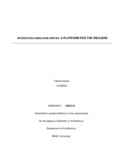| dc.contributor.advisor | Doza, Sajid Bin | |
| dc.contributor.advisor | Reza, Habib | |
| dc.contributor.advisor | Ghani, Shams Mansoor | |
| dc.contributor.advisor | Kibria, Naim A | |
| dc.contributor.advisor | Jabeen, Huraera | |
| dc.contributor.advisor | Ahmed, Iftekhar | |
| dc.contributor.author | Kamal, Tasmia | |
| dc.date.accessioned | 2018-04-16T06:05:26Z | |
| dc.date.available | 2018-04-16T06:05:26Z | |
| dc.date.copyright | 2018 | |
| dc.date.issued | 2018 | |
| dc.identifier.other | ID 12108024 | |
| dc.identifier.uri | http://hdl.handle.net/10361/9882 | |
| dc.description | This thesis is submitted in partial fulfillment of the requirements for the degree of Bachelor of Architecture, 2018. | en_US |
| dc.description | Cataloged from PDF version of thesis. | |
| dc.description | Includes bibliographical references (page 71). | |
| dc.description.abstract | Handloom, the tradition of weaving clothes by hands, is one of the richest aspects of Bangladeshi culture and heritage .Traditionally being the largest rural industry in Bangladesh, it is the second largest source of rural employment and income after agriculture and is responsible for a very high percentage of the nation's economy. However, today, this prospective commerce is facing threats of extinction because of various problems and obstructions, thus compelling the weavers to leave their holistic profession, weaving. The weavers, who play an instrumental role in the development of this sector, are deprived from all kinds of basic needs and wages which questions their livelihood and force them to leave their profession. This beautiful process of turning individual fibers into fabrics is very intricate and deserves high recognition and value. However, the reality is far away from this. Glorious past, confusing present and questionable future; is the ultimate harsh truth that handloom, the biggest handicraft industry of our country is facing now. This paper discusses the approach chosen for the benefit of the weavers’ community by taking inspiration from the past and implementing it for the future, thus adding to its potential. It’s like an institution within itself which benefits the entire complex as one unified whole. This handloom center, informal and accommodating of the weavers’ language is basically an interactive platform for the welfare of the weavers’ community, and in greater aspect for the entire country. The main aim of this paper is to deal with the actual scenario of the current situation, identify the limitations and strengthen the possibilities with the intention of preserving the existence of our beautiful handloom fabrics through a collective attempt. | en_US |
| dc.description.statementofresponsibility | Tasmia Kamal | |
| dc.format.extent | 71 pages | |
| dc.language.iso | en | en_US |
| dc.publisher | BRAC University | en_US |
| dc.rights | BRAC University thesis reports are protected by copyright. They may be viewed from this source for any purpose, but reproduction or distribution in any format is prohibited without written permission. | |
| dc.subject | Handloom | en_US |
| dc.subject | Weavers | en_US |
| dc.subject | Customer | en_US |
| dc.subject | Market | en_US |
| dc.subject | Housing | en_US |
| dc.title | Integrated handloom center: a platform for the weavers | en_US |
| dc.type | Thesis | en_US |
| dc.contributor.department | Department of Architecture, BRAC University | |
| dc.description.degree | B. Architecture | |

